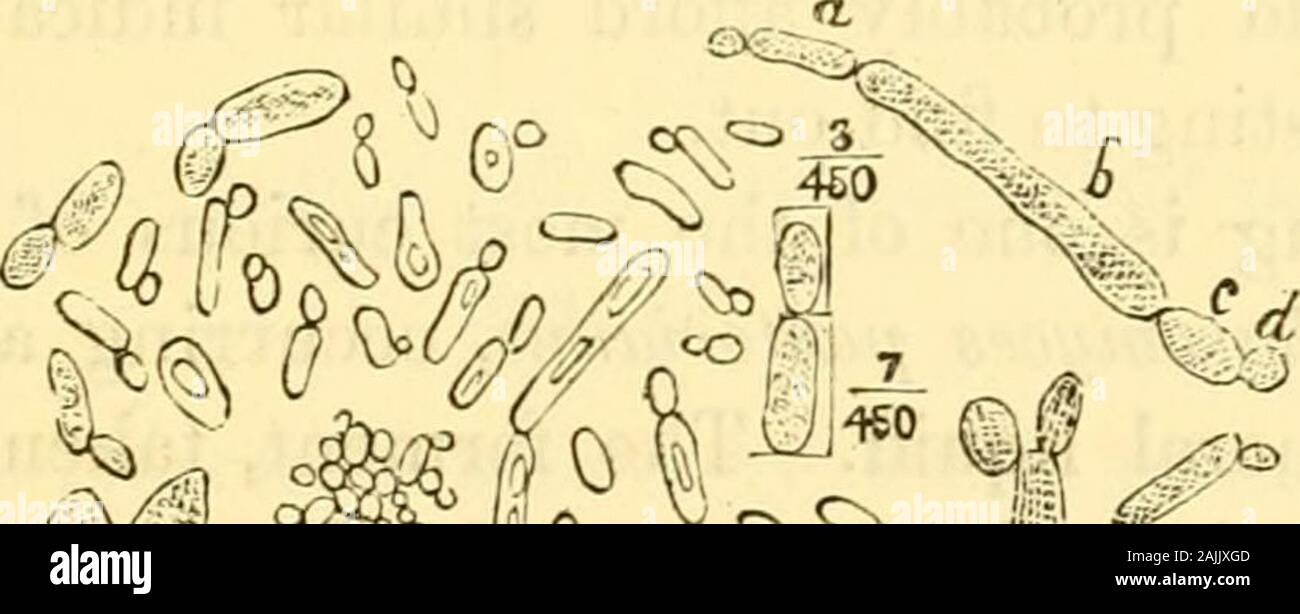Studies on fermentation : the diseases of beer, their causes, and the means of preventing them . r tohave originated from a round ferment. The cells are muchexhausted, and most of them seem to have a double border;their interior is very granular and of a yellowish colour.One might readily take the specimen to be a dead oldferment, which, however, it by no means is. Fig. 36 represents the germination of this ferment, whichhad previously been revived in a flask of wort, at the tempera-ture of the air, in May, 1875. The following are the details ofour observation :— We sowed a trace of the exhaus

Image details
Contributor:
The Reading Room / Alamy Stock PhotoImage ID:
2AJJXGDFile size:
7.1 MB (198.3 KB Compressed download)Releases:
Model - no | Property - noDo I need a release?Dimensions:
2489 x 1004 px | 21.1 x 8.5 cm | 8.3 x 3.3 inches | 300dpiMore information:
This image is a public domain image, which means either that copyright has expired in the image or the copyright holder has waived their copyright. Alamy charges you a fee for access to the high resolution copy of the image.
This image could have imperfections as it’s either historical or reportage.
Studies on fermentation : the diseases of beer, their causes, and the means of preventing them . r tohave originated from a round ferment. The cells are muchexhausted, and most of them seem to have a double border;their interior is very granular and of a yellowish colour.One might readily take the specimen to be a dead oldferment, which, however, it by no means is. Fig. 36 represents the germination of this ferment, whichhad previously been revived in a flask of wort, at the tempera-ture of the air, in May, 1875. The following are the details ofour observation :— We sowed a trace of the exhausted yeast (Fig. 35) in aflask of wort on May 16th. The sketch (Fig. 36) was madeon May 19th, but on the 18th there was a sensible revival. Itwill be seen how much the little ferment had developed inthe course of three days from the time when the process com-menced. If we had waited a few days longer before takingour sample, we should probably have had difiiculty in findingany cells or filaments of the large ferment form, as there wouldhave been so few of them in comparison with the others.. Co Fig. 36. In the above figure we should remark the chain of largecells and long-jointed processes, a, h, c, d: d is one of the cellsthat we sowed ; it has become transparent, and its contents, which are slightly granular, have lost their brownish tint; c isa large cell which sprang from the preceding one ; its outline 176 STUDIES ON FERMENTATION. is clear, and it is full of fine, yellowish granules, which presenta perfect resemblance to the large ferment-cells of fruits, pro-ceeding from the germ-cells on the surface of those fruits, when it begins to appear in sweet juices; 6 is a long filament, sprung from the preceding cell; and, last of all, a is a jointand its hud, in which the border is not yet very clearly defined;it has scarcely any granules, and is finer than the others, be-longing, in short, to the small ferment form represented inPlate XI. Here, then, we see the transition of the